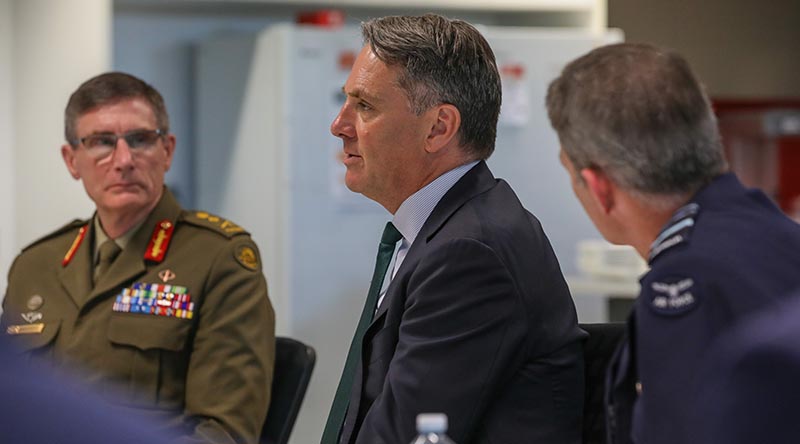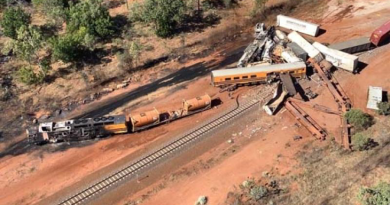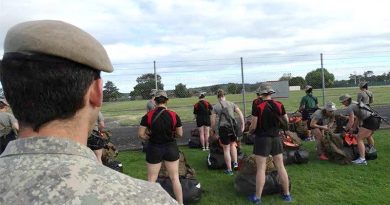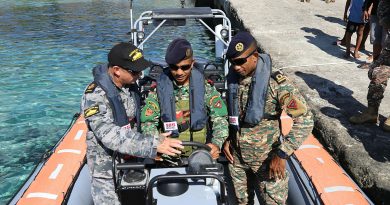Defence chiefs ‘react’ to Strategic Review’s major changes
Share the post "Defence chiefs ‘react’ to Strategic Review’s major changes"

Defence chiefs have [politely?] described the release of the Defence Strategic Review as a “significant moment” in Australia’s approach to developing its military capability.
FILE PHOTO (December 2022): Deputy Prime Minister and Minister for Defence Richard Marles speaks to Defence hierarchy about defence in the space domain in Canberra. Photo by Corporal Brenton Kwaterski.
Government released the review on 24 April, saying it “sets the agenda for ambitious but necessary reform to Defence’s posture and structure”.
The review identified six priority areas for immediate action:
- Investing in conventionally armed, nuclear-powered submarines [which was already decided and locked in long before the government who commissioned the review was elected]
- Developing the ADF’s long-range strike capability, including manufacturing munitions in Australia
- Improving the ADF’s ability to operate from Australia’s northern bases
- Lifting capacity to rapidly acquire disruptive new technologies
- Investing in the growth and retention of a highly skilled workforce
- Deepening diplomatic and defence partnerships with key regional partners
- [gutting Army’s Plan Keogh – though, to be honest, that decision was on the cards before the review was commissioned]
Chief of the Defence Force General Angus Campbell said this was a “critical time for Defence and our nation”.
“The deteriorating strategic environment presents challenges that require the ADF to have the capacity to defend Australia and our immediate region, including our northern approaches,” General Campbell said.
“To deter adversaries through denial, meet our evolving strategic needs and respond as required, the ADF will have accelerated capability development, higher levels of military preparedness and enhanced lethality.”
He said the ADF would undertake a modernisation agenda over the coming decade to build an integrated, focused force across the maritime, land, air, space and cyber domains.
Chief of Army Lieutenant General Simon Stuart said Army would continue to be an expert contributor to the integrated force.
“We need to adapt quickly to the rapidly changing character of war,” Lieutenant General Stuart said.
“There will also be changes to the scale and scope of our capabilities, the sequence and pace of delivery, how we are organised, how we train and the resources that will be available to us.”
The combined-arms fighting system would be “significantly smaller, but no less capable” [sorry, does not compute!].
“We’ll accelerate delivery of our long-range fires and littoral manoeuvre capabilities.
“Our formations will become more specialised [surely not a good thing?], and we will increase the use of robotics and autonomous systems, artificial intelligence and quantum technology,” he said.
Lieutenant General Stuart said more work was being done on the details of how Army will be re-postured and restructured, and these would be shared by the end of August.
Chief of Navy Vice Admiral Mark Hammond said the review provided clarity around the expectations of a more focused and integrated ADF, with specific capabilities to execute a strategy of denial that can impose an unacceptable cost on a potential adversary.
“This requires a bold alteration for Defence,” Vice Admiral Hammond said.
“This alteration allows us in Navy to look hard at our priorities for the next decade and ruthlessly refocus on how to get maximum warfighting return for the Australian taxpayer.
“The three main concepts guiding Navy’s thinking in implementing the review will be its people, provision of naval power and future maritime-domain capability.”
He said Navy was already focused on optimising its workforce and this would continue in light of the review, since “people are our only way to achieve a decisive edge and the review highlights that a platform without a crew is not a capability” [except in the case of un-crewed platforms, of course – which are heavily pushed in the review].
Vice Admiral Hammond added that while Navy would look “towards the horizon of a more lethal Navy” [platitude much?], the review also reinforced the need for soft power, allowing Navy people to be ambassadors for the country and “contribute to a peaceful and prosperous Indo-Pacific”.
Royal Australian Air Force is also working on the details, with Chief of Air Force Air Marshal Rob Chipman and Warrant Officer – Air Force Ralph Clifton saying in a joint message that RAAF strategy would be reviewed to ensure the approach to air and space power aligned with the integrated approach set out in the Defence review.
“In an integrated force, we will have a common purpose irrespective of where we work in the organisation.
“We will measure our air and space contribution as a Defence output, not a Royal Australian Air Force output.
“We will be equally invested in the capability outcomes of all domains,” [the RAAF leaders magnanimously said, as if they had a choice in the matter].
“Recent initiatives, such as improvements to internal structures and manoeuvring air power across northern bases, will form part of RAAF’s implementation of the Defence review.”
Related stories:
Download the government’s response to the Defence Strategic Review here.
CONTACT’s key extracts from the Defence Strategic Review
Australian defence industry reps disappointed with DSR
Long-range rockets ordered for Army/RAN before Strategic Review finalised
$19billion for long-range strike
$3.8billion for northern bases
.
.

.
.
Share the post "Defence chiefs ‘react’ to Strategic Review’s major changes"






If you want to know what this is all about then read this https://mca-marines.org/wp-content/uploads/TM-EABO-First-Edition-1.pdf
Blows my mind that they review shrugged its shoulders in terms of how out navy will be structured and had to go, again, to the US for the answers